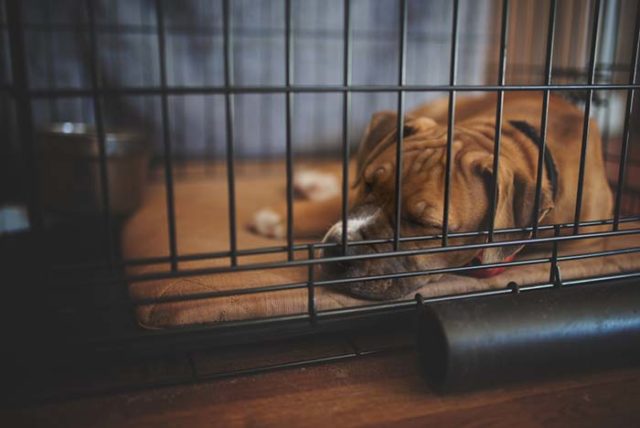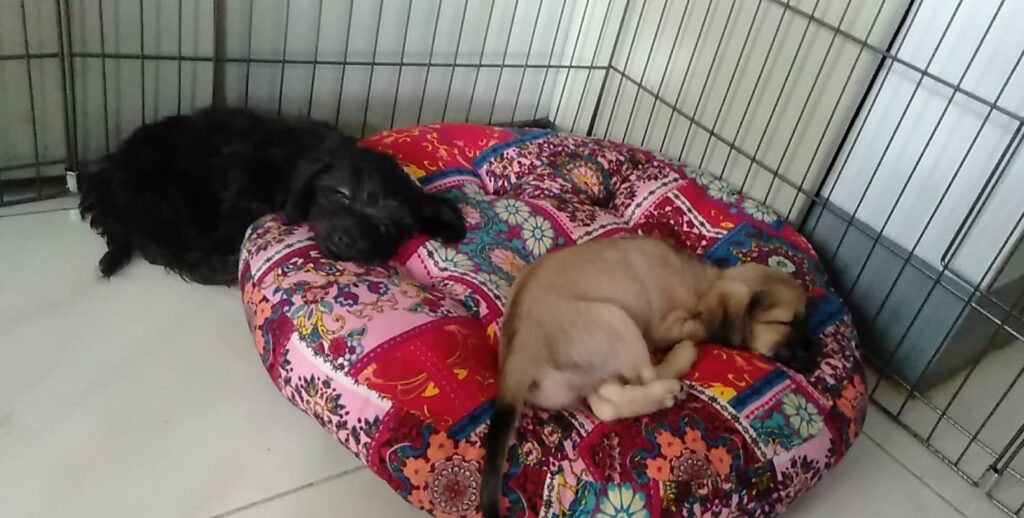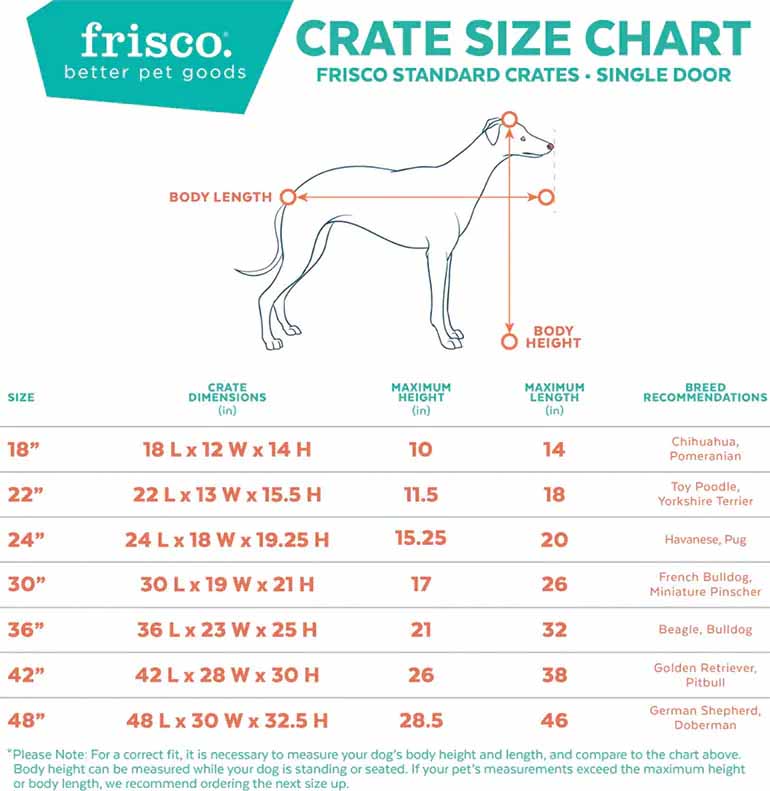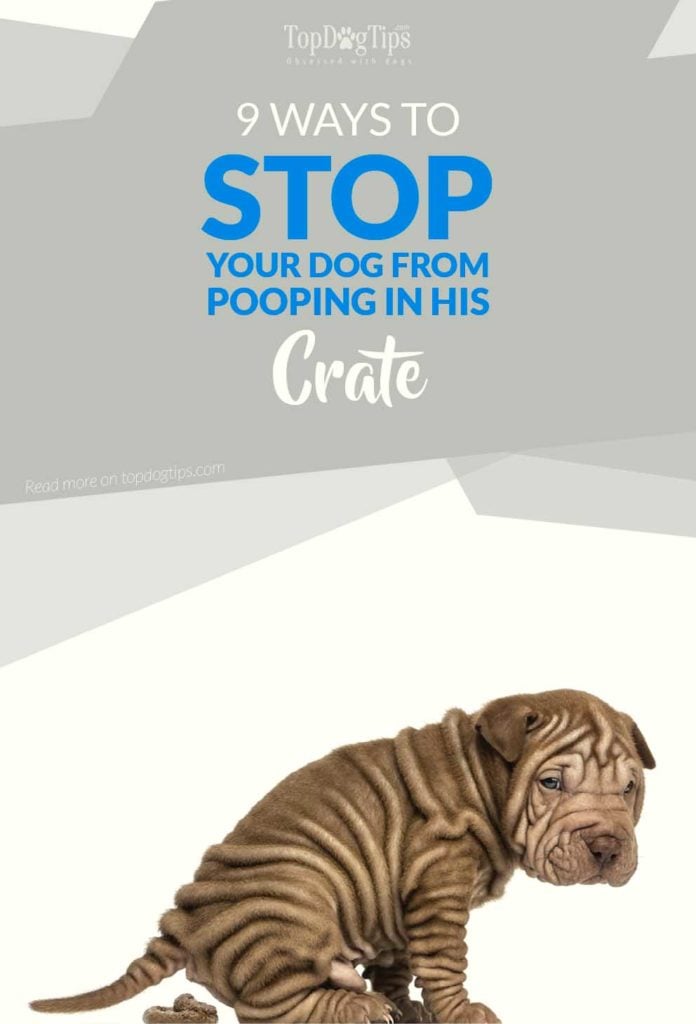
Table of Contents
Are you finding it difficult to stop your dog from pooping in his crate?
I get it. I had the same problem, too, when I got my pups!
My dogs, Zorro and Budak, have been very close since they were born, so we decided to buy a fence big enough to house them both.
We also bought them a training toilet just placed outside this fence.
So far, so good. Until they peed and pooped.

See the red bed they're sleeping on?
During the day, they often use that as their very own toilet.
They don't just ignore the training toilet; they avoid it.
If you're chuckling while reading this, you probably have the same experience as I did.
But don't worry. We got past it, as I'm sure you will too.
There are a few simple ways you can stop your dog from pooping in a crate, which we will talk about later.
Pooping in a crate is normal for young puppies who are yet to be trained.
However, this could also indicate that something is medically or emotionally wrong with the dog, especially if he's already an adult.
As my vet advised, try to pay attention to your dog's poop the next time he goes.
If you loose/runny stools, there's probably an underlying medical condition that's making it difficult for him to hold it in.
It's best to consult an expert immediately about this.
But if their stool is firm and has a normal color, then their behavior might be caused by the following:
- Improper or lack of training
- Incorrect dog crate size
- Bad habits they already got used to
- Other possible causes which we included below.
So as promised, here are 10 proven ways that helped me stop my dogs from pooping in their crate, which will hopefully help you too!
10 Ways to Stop a Dog Pooping in a Crate
1. Proper Potty Training
Your dog might be pooping in a crate simply because they know no better.
Duh, obviously, Jo.
But hear me out.
Before crating your dog for an extended period of time, he must be housebroken first.
This was my first mistake.
I immediately housed my dogs in their fence without letting them get used to a set schedule first.
As you know, housebreaking means that they will also be trained to go potty at a specific time and a specific place.
Of course, you can still use a crate while you're house training your dog, but only for a short period of time.
Speaking of time, this brings me to our 2nd solution…
2. Crate Stay Duration
How long are you keeping your dog in the crate?
With Zorro and Budak, I usually keep them in their fence when I'm cleaning the house and before sleeping at night.
However, as I mentioned, they weren't housebroken, so they didn't learn to follow a scheduled time for bathroom breaks.
When you crate your dog, ensure the time does not interfere with the dog's bathroom-walk schedule.
It would be best if you don't keep your dog in the crate for too long.
But dogs are denning animals, right? They need to be in their own den!
Nope.
Despite the myth, dogs are not denning animals, and some do not prefer to stay in them, especially for an extended period of time.
Oh, and your dog's age is a big factor, too.
Adult dogs can hold it in longer than puppies.
The recommended maximum time for a puppy under 4 months to stay in a crate is up to 4 hours.
A puppy around 6 months can stay up to 5 hours, and an adult dog can stay up to 6-8 hours.
But if they have crate anxiety (as we're about to dive into next), pooping could really happen regardless of age.
3. Anxiety
I remember the first time I left my dogs in their crate while I went to the market.
I wasn't even gone for more than an hour, as the market was just 2 blocks from my apartment.
When I returned, they sure had a fresh surprise waiting for me on their bed.
Other than any other health issues, dogs may also poop in a crate because something causes them anxiety.
Crate anxiety is real, and not all dogs can tolerate crates due to claustrophobic fear of confinement and/or solitude.
After you place your pet in a crate, watch out for signs of stress.
If any distress is present, that often leads to peeing and pooping uncontrollably.
If your dog suddenly has diarrhea, that could be another symptom of his anxiety.
4. Exercise
Plenty of exercise benefits a crated dog in more than one way.
It tires out the dog, making them less likely to whine, misbehave, and poop in a crate.
And if your pooch is usually active at night, tiring him out before bed will help him go straight to sleep.
In fact, according to Dr. Michele K., DVM:
A few things that might help would be to make sure that he is walked before bed and has timed meals so that he isn't eating right before bed, either.
Regular walks, playtime, and exercise also help the dog's mind connect routines.
As you know, potty habits align with other routines, such as walks and meals.
And speaking of feeding your dog…
5. Feeding Times
Routine is crucial for our dogs.
That's why you should try to feed your pets at the same time throughout the day.
Why?
So you can predict when they're about to go.
Many dogs tend to poop about 30 to 60 minutes after their meals.
This means if you feed them, make sure it's not right before you're about to crate them.
As Adrienne Farricelli from PetHelpful puts it:
“Try feeding food no less than six hours before your puppy is crated for the night.
For example, if your puppy is crated for the night at midnight, plan to feed no later than 6pm.
The later a puppy is fed, the more likely he's going to defecate overnight.”
Trust me, don't beat yourself up; we all think we should think things through because of common sense, right?
But of course, I did that when I first had my puppies, thinking nothing of it.
And another no-brainer piece of advice: hold off keeping or putting food in the crate until you're confident that your dog can hold it in for long enough.
Especially if the kibble or treat has a history of not sitting well in your dog's tummy.
Which brings us to number 6…
6. Choosing The Right Dog Food and Treats
If you're a new puppy owner, you're probably still trying to figure out if your pet has food sensitivity.
But if he's been with you for quite a while, you might know this already.
Thankfully, in my case, my dogs aren't too picky with what they eat or chew on (shoes included!)
Just make sure that whatever you give your pet agrees with his stomach.
Some dog foods and treats may upset a dog's stomach, cause diarrhea or otherwise mess with a dog's bathroom schedule.
Because if you're leaving a peanut butter stuffed KONG toy in the crate, and your dog won't stop pooping in the crate, then peanut butter could be the cause.
7. Remove Any Blanketing
Do you put blankets in your dog's crate?
Our pooch could be smart and naughty at the same time.
You'll probably try to sniff around to know where the culprit is, just to find it under a blanket.
Some dogs understand they can poop in the crate and cover it up like nothing happened.
If your dog does this, it's best to remove the blanketing until it learns that laying in its mess is not the ideal way to spend time in a crate.
8. Training
How do you know your dog isn't training you (a.k.a. manipulating you) instead?
Even if you follow all crate training rules, some dogs still learn that pooping in a crate equals being allowed out.
If you suspect this to be the issue, consult a professional behaviorist to discourage the dog from this behavior.
You will use positive reinforcement and redirection to stop your dog from being smarty pants.
9. Crate Size
Dogs will poop if the crate size is too big. When a crate is too large, dogs may treat part of it like a backyard. Poop on one side, sleep on the other.
And boy, did Zorro let me know that their fence was WAY TOO BIG, even for two of them!
Choose dog crates based on their age and size.
When a crate is too small, however, it may be too uncomfortable.
It can cause them stress and anxiety, which also results in pooping.
To get the perfect dog crate size for your Fido, refer to this dog crate sizing chart we found.
10. Health Issues
Jo, I've exhausted all my options, but my dog still does it. What more should I do?
First of all, calm down.
If you feel you've done all you can to stop your dog from pooping in a crate, just bring him to the vet!
Have him get a health check-up to ensure no medical issue is causing this problem.
I'm sure your vet will also advise you on food options if that's the cause of your dog's pooping habits.
When Nothing Else Works
So, you've done all 10 steps.
You've even ruled out any medical conditions with the help of your vet.
But your dog is still treating his crate like a toilet?
There are two more things you could give him. More time and more patience.
During this time, you're also going to need supplies to decrease the “damage” done by your dog's poop.
Training Pads
Get yourself some training pads to lay them out in the crate.
This is a temporary solution but will help to deal with poop in the crate.
Sure, they're primarily designed for dog urine.
But pee pads are still helpful in absorbing the feces and even locking in the smell.
And besides, would you rather he do it on the blanket or the bed?
Training pads are your best bet in containing and cleaning the mess in the crate much easier.
Pet Diapers
An appropriately sized set of pet diapers can also help you and your pooch temporarily.
After all, they're commonly used in puppies and senior dogs who are having trouble holding their poops and pees in.
However, if your pet is like my dogs who hate the idea of diapers and can remove them in a snap, I recommend the training pads.
Most dogs will not feel comfortable wearing diapers, so this should only be used as a last resort and only for a short period.
Other tools that can help you temporarily deal with this problem are trays that you can place in the crate (ideally, with pee pads.)
You can also use pet odor eliminators that contain enzymes to discourage the dog from pooping where you spray it (this is my favorite)
Below are some of the best products I used for this problem.
| Preview | Product | Rating | |
|---|---|---|---|

|
MidWest Homes for Pets Replacement Dog Crate Pan... | 47,543 Reviews | Check Price |

|
Sunny & Honey Pet Stain & Odor Miracle - Enzyme... | 10,696 Reviews | Check Price |

|
Amazon Basics Dog and Puppy Pee Pads with 5-Layer... | 250,855 Reviews | Check Price |

|
Rocco & Roxie Supply Co. Stain & Odor Eliminator... | 110,835 Reviews | Check Price |
Dog Daycare
Have you considered getting your dog in daycare?
This might be the better solution than keeping your dog in a crate with you-know-what!
I highly recommend you look for the best doggy daycare around your area, especially if your main reason for crating is because you're leaving the house.
Not only is this the more humane solution, but your dog could also learn some cool tricks!
We wrote a couple of equally cool articles, too, about doggy daycare that you can read here:
- Is Dog Daycare Good For Dogs?
- Dog Daycare for Anxious Dogs
- Dog Daycare vs. Dog Boarding
- Do You Tip in a Dog Daycare?
Dog Sitter
If you don't like the idea of leaving your pooch somewhere, he's unfamiliar with, why not get a dog sitter instead?
You could either get someone you know or hire a professional sitter instead!
While you're away, they can take your Fido out for his bathroom breaks.
You can book a dog walker for specific times during the day.
It's convenient, too, as it has plenty of easy-to-use apps and services.
Dog Pooping in a Crate: Final Thoughts
Hopefully, these tips will help you deal with your pooping pooch problem as they helped me and my dogs.
It will take a lot of your patience (trust me, I know!)
But seeing your dog learn and know better because of your love and help is priceless.
Good luck, fur parent!
Related Articles:
- 8 Tips on How to Stop a Dog From Peeing in the Crate
- Crate Training a Puppy: 22 Tricks and Tips
- Crate Training an Older Dog: The Best Way to Kennel Train and 10 Lessons
Disclosure: We may earn affiliate commissions at no cost to you from the links on this page. This did not affect our assessment of products. Read more here and find full disclosure here.
Want to share this?















